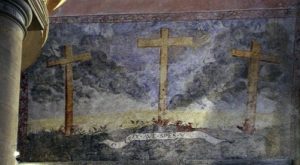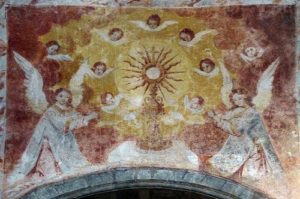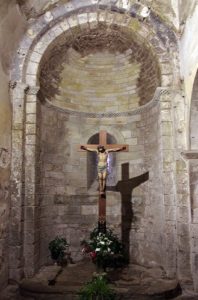In foothills of Montagne Noire, St Papoul is an old fortified town which has preserved its medieval character with narrow streets and half timber houses.
There has been an abbey here since the 8thC. Named after St Papulus, an early Christian bishop and martyr who had the top of his skull cut off. According to the legend, bent down to pick up his skull and a spring gushed out of that place. The present church is 12thC and renowned for the quality of the carving of stone figures on the capitals and corbels beneath eaves. There are the remains of frescoes on walls. It became a cathedral in 13thC. The cloister is 14thC. There was a major restoration in 17th & 18thC when the episcopal palace was rebuilt. The bishopric was abolished after the Revolution and it became the Parish Church.
There is plenty of parking outside the abbey. There is a tall offset bell tower over the north transept. This has a pointed roof and three tiers of bell windows. The nave is very tall with Romanesque windows and big buttresses. The apse is tall with narrow buttresses and carved corbels with heads, under the roof. There is a very small north apse. The south apse is later.
Entry is through the shop into the large refectory building which now has an exhibition of bishops vestments and carvings. There are a carving of Daniel, unharmed in the lion’s den and another showing the punishment of those who had accused him. “And the king commanded, and they brought those men which had accused Daniel, and they cast them into the den of lions, them, their children, and their wives; and the lions had the mastery of them.”
There is a Nativity scene with the magi and a scene showing the flight into Egypt. There is a delightful carving of two midwives bathing the baby Jesus. In a case is a most beautiful 18thC Reliquary described as un retable paperolle with quilling patterns. It contains the relics of Philippe Néri who was founder of l’Ordre de l’oratoire. In the centre is a bust of Philippe Néri with a gilded quilling pattern on the panel behind him. He is set under an arch with pillars which support arches of filigree leaves and flowers. The pillars are decorated with garlands of quilling flowers and leaves and there is another garland under the bust. The workmanship is amazing.
The refectory leads out into the cloisters. These are unusual as the pillars are made of brick with a render covering which is coming off in places. Many of the capitals are badly eroded. The Chapter House is on the west wall has has ‘water flower’ on the capitals and a plain, but slightly pointed arch above the door (locked). The double window has a central pillar with ‘water flower’ capitals. On the north wall is a small, unidentified room which has some lovely carved heads in the pillar capitals.
Wooden doors lead into the porch of the church with two red and grey flecked marble stoups and a memorial to the dead of World War One. A second set of doors leads into the abbey.
This wasn’t at all what we had expected with a glorious Baroque chancel.
Pillars are painted to resemble marble and covered with gilt decoration. The chancel arch is painted and has gilt decorative carving and a gilt sunburst at the top. The walls facing the nave are painted. Around the bottom is a set of ornate wrought iron altar rails. There is a free standing mass altar with a painted baptism scene on the base of a bishop blessing people. Behind is a marble altar with tall silver candlesticks. (There are wooden stairs at the back for lighting them).
There is a gilded canopy with a crown over the bishop’s chair. Next to it is a high back chair with a canopy. The back of the chancel is lined with high backed choir stalls and there is a big green and gilt bookstand to hold the music books.
The ribbed ceiling has painted ribs and trompe d’oeil vaults between them with Gothic arches painted in shades of beige and brown with mock bosses. Marble painted wall pillars have carved capitals with a cherub’s head underneath.
The Romanesque windows have modern stained glass windows with images of saints. On the south wall an elaborate Gothic arch which contains an engraved reliquary box of St Papoul.
A round stone arch leads into the south apse which has a small altar with a statue of the Virgin Mary surrounded by flowers and candles. This is set in a Gothic arch with pinnacles containing a smaller statue of the Virgin. The walls are painted pale beige with an outline square pattern with darker brown four petalled flowers. The arches of the vaulted ceiling are painted in geometric patterns of blues, reds, greys and yellows. The ceiling between the arches is pale grey with a blue motif. On the north wall is an elaborate Baroque tomb with a kneeling marble statue of a bishop set in a portico with pillars and a shield with cherubs on the top.
The north apse is smaller and much simpler. It is a plain Romanesque apse with a dome ceiling. A central rib has cherub heads at the corners and there is a narrow dog tooth frieze around the top of the walls. On the east wall is a crucifix.
The north aisle has an altar with a M monogram on the front. Above is a gilt host box with an image of Christ having ben scourged. On either side are scenes of the Annunciation and the Assumption of the Virgin. Above is a painted statue of a bishop.
There are a series of small chapels along the north wall. The first has a marble altar with host box and candles. There is a statue of Joseph and the boy Jesus on the wall above. On a table to the right is a gilded two door cupboard with two gilded busts on it. Next is a chapel with marble altar with gilded Virgin and child on the wall above with the gilded head of a bishop on either side.
The next chapel has a massive grey and red flecked marble altar rail . Behind is a superb marble altar with a sheep on the base and a marble host box in an elaborate stand. There is a gilded figure of St Peter on the left and St Paul on the right. Above is a large oil painting of the crucifixion. On the wall above is the remains of a fresco with a monstrance surrounded by cherub heads and an angel on each side.
The back chapel has a gilded figure of Mary holding the dead body of Christ. On the wall above is a fresco of the three crosses.
At the back of the church, big stone pillars support the organ. There are statue of St Berenger and St Dominic.
This was a very well worthwhile stop. Unfortunately it was getting late so we didn’t have time to walk round the village.










